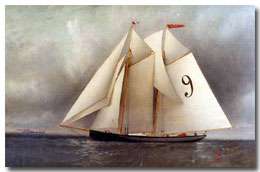Pet, No. 9
 Pet, No. 9 | |
| History | |
|---|---|
| Name: | Pet |
| Owner: | New York Pilots |
| Operator: | Joseph Henderson |
| Builder: | Charleston, Mass. |
| In service: | circa 1876 - 1885 |
| Out of service: | sank at sea |
| General characteristics | |
| Displacement: | 54 ton |
| Length: | 54 feet |
| Beam: | 21 feet |
| Propulsion: | sails |
| Sail plan: | Schooner-rigged |
| Notes: | Signal letters, 399-20-175 |
The Pet No. 9 was pilot boat in the Port of New York and New Jersey for what has become the Sandy Hook Pilots.
Construction and Service
The pilot-boat Pet, No. 9, was registered in the New York Record of American and Foreign Shipping from 1876 to 1885. For fourteen years Joseph Henderson (pilot) was commander of the pilot boat Pet.
The pilot boat “Pet” is also listed in the book, Pilots and Pilot Boats of Boston Harbor. In the book the following information is listed about the pilot boat, “The Pet, a boat of 54 tons, steered by means of a tiller, was built in 1866 by Edward E. Costigan at Charlestown, Mass, for Pilot Captain Abel T. Hayden. She was in service for a number of years and was considered a very handsome pilot boat.”[1]
On November 5, 1872, Joseph Henderson spoke at a meeting of the Board of Commissioners of Pilots about how he and his boat Pet, No. 9, rescued the crew of the brig Emily. Joseph said: “Gentlemen: I respectfully report that on Monday Oct. 28, Block Island bearing north, forty miles distant, the pilot-boat Pet, No. 9, it blowing a gale of wind east by north-east, fell in with the brig Emily, from Jacksonville, bound to Boston, in a sinking condition, colors flying union down: went to her and spoke her; the master wished to abandon the vessel as the sea was making a clean breach over her and she could not float much longer.”[2]
On February 3, 1877, an article from the Spirit Of The Times newspaper talked about the pilot-boat PET, which was number nine of the New York Harbor fleet. The article said: “There is something attractive in the very notion of a pilot-boat. It is associated with thoughts of exposure, hardship, and danger, to be sure, but undergone by men who ever with a frolic welcome take the tempest and the sunshine, and oppose mere hearts, free foreheads, and great as the risks may be, there is always a sense of security about a pilot-boat, because it is manned by those who are specialists in the peril of the sea, who can detect the faintest premonition of a storm, and have weathered it out in the severest of gales. The eyes of the passengers who cross the ocean on the mammoth steamships arc strained, as they near the land, for the first glimpse of the tiny cockle-shell which bears the pilot, and when his foot strikes the deck of the great vessel, he is welcomed not only as a fresh-comer from the longed-for shore, but as the man of ability, to whom everything is entrusted. Nothing is too good for him. He is lord of all."
"Even those who hare never seen the sea join in the sentiment, which attaches to pilots; in all minds they are privileged and popular members of the community. This week. In connection with a picture of the pilot-boat Pet, Joseph Henderson, Captain, we give a brief sketch, the object of which is to explain how the business of these craft is conducted in the port of New York. The Pet is selected simply as an example of her class, not because of her superiority over others, though she is acknowledged to be one of the best pilot-boats afloat. She is, like all the others, schooner-rigged, 125 tons burthen, 78 feet long, 21 ½ feet beam, 8 ½ feet depth of hold, draws 11 feet aft, and 6 ½ feet forward, and spreads about 1,800 yards of canvas to the three lower sails.”[3]
On November 21, 1889, Joseph was commander of the pilot boat Pet, No. 9, which was lost in Newport, RI, harbor. "She dragged her anchor near Mackerel Cove, Rhode Island and drove ashore, proving a total loss. The agile Henderson escaped with his life." [4]
References
- ↑ Eastman, Ralph, M., (1956), "Pilots and Pilot Boats of Boston Harbor," Boston, Massachusetts, Page 83.
- ↑ ProQuest Historical Newspapers The New York Times, pg. 2.
- ↑ "The Pilot-Boat Pet" (PDF). New York NY Spirit Of Times. 1877-02-03. Retrieved 2013-01-11.
- ↑ Charles Edward Russell, "From Sandy Hook to 62°", page 151; The New York Times, page 3; The Brooklyn Eagle